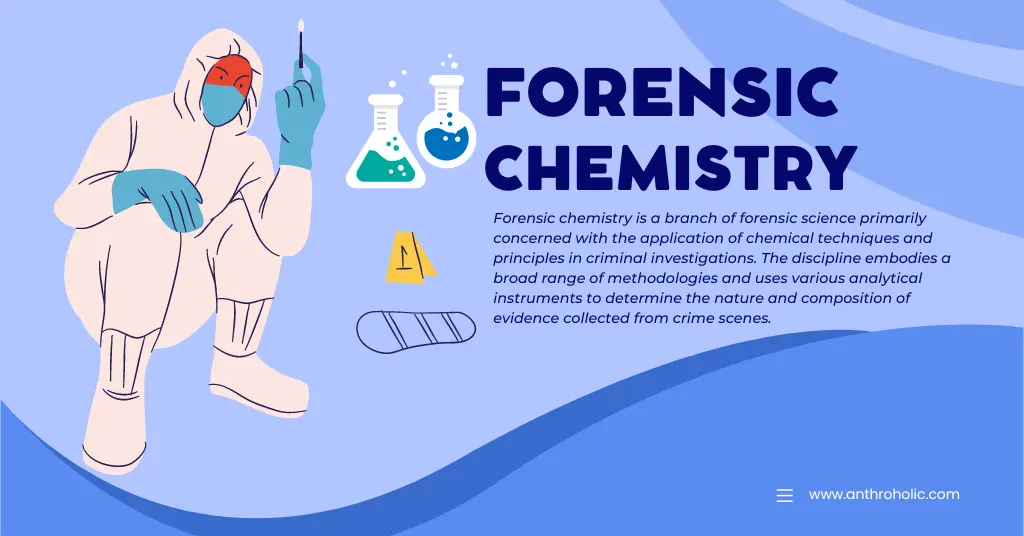AI Answer Evaluation Platform Live Now. Try Free Answer Evaluation Now
Forensic Chemistry
Forensic chemistry is a branch of forensic science primarily concerned with the application of chemical techniques and principles in criminal investigations. The discipline embodies a broad range of methodologies and uses various analytical instruments to determine the nature and composition of evidence collected from crime scenes [1]. It plays a crucial role in the legal system, aiding in solving crimes and bringing offenders to justice.

Fundamentals of Forensic Chemistry
Forensic chemistry revolves around the scientific analysis of physical crime scene evidence. The field employs a wide variety of chemical and instrumental techniques to scrutinize evidence and make vital conclusions.
Types of Forensic Analysis
Forensic chemists often engage in multiple types of analysis:
- Drug Analysis: Identification and quantification of illegal substances.
- Trace Evidence Analysis: Microscopic examination of fibers, paint chips, or soils.
- Fire and Explosives Analysis: Examination of debris from fires or explosions.
- Toxicology: Identification of poisons and toxins in bodily fluids.
Role in Crime Scene Investigation
In the context of a crime scene, forensic chemists perform the following tasks:
- Collecting and preserving physical evidence.
- Analyzing the evidence in laboratories.
- Interpreting the results and providing expert testimonies in court.
Analytical Techniques in Forensic Chemistry
The field of forensic chemistry utilizes an array of analytical techniques, each serving unique purposes [2].
Spectroscopic Techniques
Spectroscopy involves the interaction of light with matter. Techniques include:
- Infrared (IR) Spectroscopy: Provides information about functional groups in an unknown substance.
- Nuclear Magnetic Resonance (NMR) Spectroscopy: Helps identify the molecular structure.
- UV-Visible Spectroscopy: Assists in determining the concentration of an analyte.
Chromatographic Techniques
Chromatography separates mixtures into individual components. Examples are:
- Gas Chromatography (GC): Used in the analysis of volatile substances.
- High-Performance Liquid Chromatography (HPLC): Applied in the analysis of non-volatile substances.
- Thin Layer Chromatography (TLC): Frequently used for quick, cost-effective analysis.
| Technique | Advantage | Common Use |
|---|---|---|
| IR Spectroscopy | Identifies functional groups | Substance identification |
| NMR Spectroscopy | Elucidates molecular structure | Substance identification |
| UV-Visible Spectroscopy | Measures analyte concentration | Substance quantification |
| GC, HPLC, TLC | Separates mixture components | Substance separation and identification |
Case Studies of Forensic Chemistry
The effectiveness of forensic chemistry is best illustrated through real-life cases where it played an instrumental role.
The Murder of Mary Phagan
In 1913, Mary Phagan was found murdered in a pencil factory. Forensic chemistry revealed that the red stains on a shirt found at the home of suspect Leo Frank were indeed blood stains. The analytical evidence contributed to his conviction.
The Tylenol Murders
In 1982, seven individuals in Chicago died after ingesting Tylenol capsules laced with cyanide. Forensic chemists identified the poison and helped link all cases, prompting a significant change in the packaging of over-the-counter substances to prevent tampering.
Emerging Trends in Forensic Chemistry
The arena of forensic chemistry continues to evolve with scientific advancements, introducing new tools and techniques that enhance the efficiency and precision of forensic investigations[5].
Mass Spectrometry in Forensic Toxicology
Mass spectrometry (MS) has become the standard technique in forensic toxicology for its exceptional ability to identify and quantify compounds. Coupled with chromatographic techniques like GC or HPLC, it allows for the analysis of complex biological samples, enhancing the detection of illicit drugs and poisons [6].
Nanotechnology in Forensic Science
Nanotechnology is steadily finding its way into forensic chemistry, with applications including fingerprint detection, DNA identification, and drug analysis. Nanoparticles and nanostructured materials can offer improved sensitivity and precision in detecting trace amounts of substances [7].
Digital Forensics
As society becomes more digitized, digital forensics—investigating digital devices for evidence—has become a significant part of modern forensic science. This includes analyzing computer systems, networks, and digital devices to uncover illegal activities or recover data [8].
The Importance of Ethics in Forensic Chemistry
The field of forensic chemistry has profound implications on people’s lives, necessitating a strict code of ethics.
Forensic chemists must ensure the preservation of the chain of custody, secure unbiased interpretation of evidence, and commit to continuous learning. They should maintain confidentiality and only make statements based on solid scientific knowledge. Additionally, there should be safeguards against manipulating evidence to suit a preconceived narrative.
Conclusion
Forensic chemistry is a powerful tool in criminal investigations, combining the rigor of scientific investigation with the pursuit of justice. With advancing technology and emerging analytical techniques, its role in solving crimes is expected to expand further.
References
[1] Bell, S., “Introduction to Forensic Chemistry,” John Wiley & Sons, 2017.
[2] Inman, K., Rudin, N., “Principles and Practice of Criminalistics: The Profession of Forensic Science,” CRC Press, 2000.
[3] Dinnerstein, L., “The Leo Frank Case,” University of Georgia Press, 2008.
[4] Bartz, P. E., “The Tylenol Mafia: Marketing, Murder, and Johnson & Johnson,” CreateSpace Independent Publishing Platform, 2011.
[5] Houck, M.M., Siegel, J.A., “Fundamentals of Forensic Science,” Elsevier, 2015.
[6] Maurer, H.H., “Mass Spectrometry in Forensic Toxicology,” Wiley, 2023.
[7] Dinish, U.S., Fu, C.Y., “Applications of Nanotechnology in Forensic Science,” Springer, 2022.
[8] Casey, E., “Digital Evidence and Computer Crime,” Elsevier, 2020.
[9] Budowle, B., Bottrell, M.C., “Forensic Science Ethics: Making a Difference in Society by Engaging the Power of Science,” Springer, 2023.




